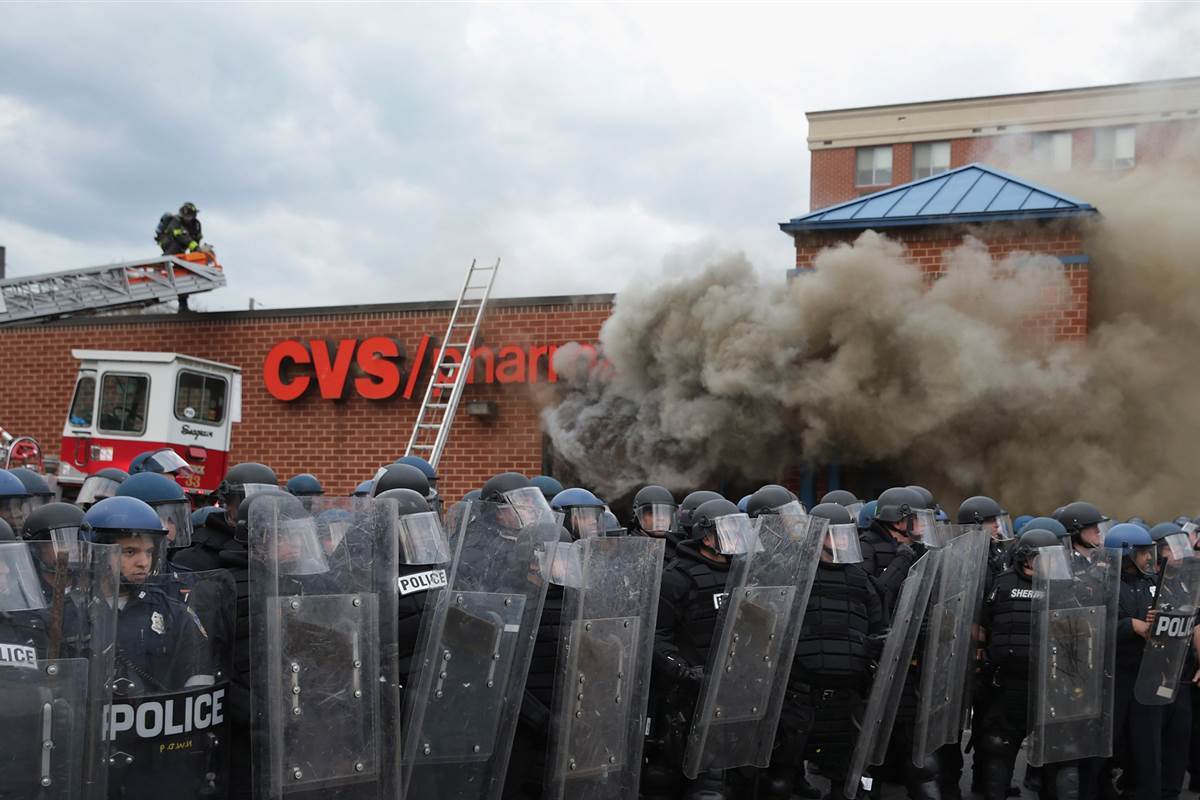
An independent report from The Johns Hopkins University released Friday details a minute-by-minute account of April’s riot and unrest following the death of Freddie Gray, concluding that, not only did the city have inadequate policies in place for mass demonstration management, it failed to recognized the “strategic and tactical distinction between routine operations and mass demonstration management.”
The study, “Recommendations for Enhancing Baltimore City’s Preparedness and Response to Mass Demonstration Events,” evaluates the city’s handling of last April’s crisis, while outlining reforms for improving policies across city agencies—not only the city police department.
Among its findings, the report offers a dramatic and comprehensive timeline of the events of April 27 when 33 building fires and 55 vehicle fires were set, and looting broke out across the city.
The report also tackles several ongoing controversies around the city’s response as these events unfolded, including the decision to halt bus service at Mondawmin Mall. That decision, on the same day as Gray’s viewing at New Shiloh Baptist Church, has widely been viewed as providing a spark to the ensuing crisis as high school students gathered at the transportation hub without the means to get home. According to Hopkins’ findings, this was a joint decision by the Baltimore Police Department, Baltimore City School Police, and Maryland Transit Administration police “to ensure MTA personnel safety” and “minimize the risk of event escalation and risk to passengers” following intelligence about a potential uprising.
As far as the assertion by the Baltimore City Fraternal Order of Police Lodge #3 that an order was sent to officers to “stand down” during the unrest, the report found that no such order was given by Rawlings-Blake or police leadership. The report also praised some of the actions of several agencies, including the police and fire departments, the transportation and health departments, the emergency management office, and public works department.
The report’s timeline, “intended to highlight the scope and complexity of events leading up to and including the civil unrest that followed the arrest and death of Freddie Gray in the spring of 2015,” begins with the shooting of 17-year-old Trayvon Martin in Florida and runs through Mayor Stephanie Rawlings-Blake rescinding the citywide curfew on May 3.
A sample of the timeline as the crisis began on Monday, April 17, after schools let out for the day and bus service at Mondawmin Mall was stopped:
4:15 pm: Local and national media report hundreds of youth congregated around the Mondawmin Mall area clashing violently with BPD throwing rocks, bricks, and bottles at police officers.
4:15 pm: The Police Commissioner and Emergency Manager request the postponement of the Orioles game to make available law enforcement resources dedicated to the game.
4:24 pm: BPD unit B31, at Fulton Ave. and Retreat St. reports that his car windows have just been broken out. He is advised by WD Sergeant and Lieutenant to get out of the area.
4:27 pm: Rioters surround several law enforcement vehicles in the 1700 block. of North Ave. 1 MTAP cruiser and 1 MTAP van are set on fire and quickly become fully engulfed.
4:27 pm: Watch Center reports to Command that a BPD patrol car is being assaulted on North Ave.
4:27 pm: BPD unit B32 reports he is sheltering for his safety in the Fresh Buy grocery store. The door does not lock. B10 requests an extraction team.
4:33 pm: BPD bearcat extricates officer from the grocery store.
4:44 pm: Individuals break into the CVS Pharmacy at 2509 Pennsylvania Ave., which closed at 3:00 pm, and begin looting the store.
The Hopkins report, according to a statement from Rawlings-Blake, comes after “a comprehensive review of communications, personal interviews, media reports, and official documents was completed by the Mayor’s Office of Emergency Management and other city agencies to provide the most accurate accounting of events as they unfolded.” The press release also notes that the timeline should be considered “a summary of activity and not intended to be an account of every single action and occurrence during this time period.”
The report’s recommendations, from the Mayor’s Office press release include:
|
“If implemented fully, we believe these recommendations will substantially improve the city’s preparedness and capacity to manage mass demonstrations and will mitigate the risk of event escalation,” said the report’s authors, led by Dr. Jonathan Links, Johns Hopkins University professor of health policy & management, emergency medicine, public safety leadership, civil engineering, and the university’s vice provost and chief risk and compliance officer. “However, we do not believe, with any set of recommendations, it is possible to completely eliminate the possibility of a riot in any major urban environment.”
